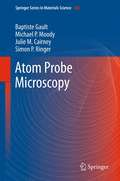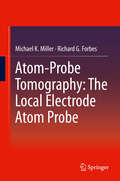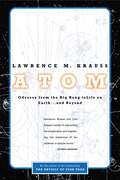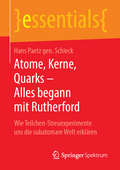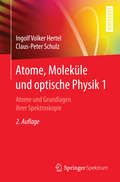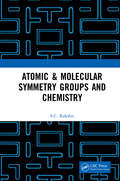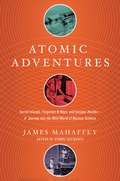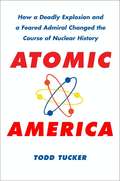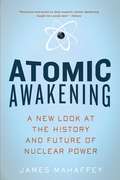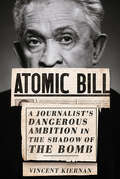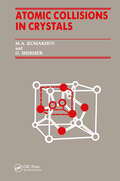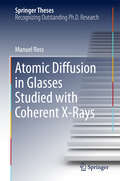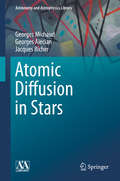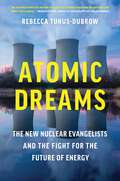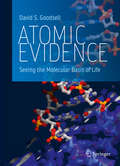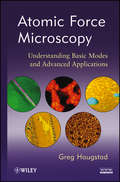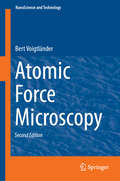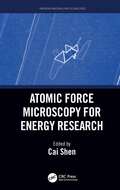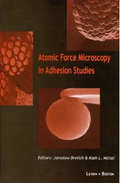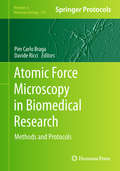- Table View
- List View
Atom Probe Microscopy (Springer Series in Materials Science #160)
by Michael P. Moody Julie M. Cairney Baptiste Gault Simon P. RingerAtom probe microscopy enables the characterization of materials structure and chemistry in three dimensions with near-atomic resolution. This uniquely powerful technique has been subject to major instrumental advances over the last decade with the development of wide-field-of-view detectors and pulsed-laser-assisted evaporation that have significantly enhanced the instrument's capabilities. The field is flourishing, and atom probe microscopy is being embraced as a mainstream characterization technique. This book covers all facets of atom probe microscopy--including field ion microscopy, field desorption microscopy and a strong emphasis on atom probe tomography. Atom Probe Microscopy is aimed at researchers of all experience levels. It will provide the beginner with the theoretical background and practical information necessary to investigate how materials work using atom probe microscopy techniques. This includes detailed explanations of the fundamentals and the instrumentation, contemporary specimen preparation techniques, experimental details, and an overview of the results that can be obtained. The book emphasizes processes for assessing data quality, and the proper implementation of advanced data mining algorithms. Those more experienced in the technique will benefit from the book as a single comprehensive source of indispensable reference information, tables and techniques. Both beginner and expert will value the way that Atom Probe Microscopy is set out in the context of materials science and engineering, and includes references to key recent research outcomes.
Atom-Probe Tomography: The Local Electrode Atom Probe
by Michael K. Miller Richard G. ForbesNanocharacterization by Atom Probe Tomography is a practical guide for researchers interested atomic level characterization of materials with atom probe tomography. Readers will find descriptions of the atom probe instrument and atom probe tomography technique, field ionization, field evaporation and field ion microscopy. The fundamental underlying physics principles are examined, in addition to data reconstruction and visualization, statistical data analysis methods and specimen preparation by electropolishing and FIB-based techniques. A full description of the local electrode atom probe - a new state-of-the-art instrument - is also provided, along with detailed descriptions and limitations of laser pulsing as a method to field evaporate atoms. Valuable coverage of the new ionization theory is also included, which underpins the overall technique.
Atom: An Odyssey from the Big Bang to Life on Earth...and Beyond
by Lawrence M. KraussThe story of matter and the history of the cosmos from the perspective of a single oxygen atom, told with the insight and wit of one of the most dynamic physicists and writers working today. Through this astonishing work, he manages to stoke wonder at the powers and unlikely events that conspired to create our solar system, our ecosystem, and us.
Atomabsorptionsspektrometrie
by Michael Sperling Bernhard WelzDer breite Einsatz der Atomabsorptionsspektrometrie wird in dem grundlegend neubearbeiteten Standardwerk anhand zahlreicher Anwendungsgebiete dargestellt. Die Beschreibung der unterschiedlichen AAS-Techniken im Vergleich ermaglicht dem Anwender, die farihn jeweils beste Lasung herauszufinden.
Atome, Kerne, Quarks – Alles begann mit Rutherford: Wie Teilchen-Streuexperimente uns die subatomare Welt erklären (essentials)
by Hans Paetz gen. SchieckHans Paetz gen. Schieck zeigt in diesem essential nicht nur, wie rasant sich das Gebiet der Atome, Kerne und Teilchen bis zu den Quarks und Gluonen entwickelt hat. Er erläutert auch, wie alles begonnen hat – hier spielt die Person von Ernest Rutherford eine alles überragende Rolle. Das Gebiet der Kernphysik und unser Wissen über die Kerne haben sich seit 100 Jahren fundamental gewandelt. Aus eher philosophischen Vorstellungen haben sich konkrete Kenntnisse entwickelt über die Bausteine unserer Welt, deren Größe und hierarchische Ordnung und darüber, welche fundamentalen Kräfte zwischen ihnen wirken.
Atome, Moleküle und optische Physik 1: Atome und Grundlagen ihrer Spektroskopie (Springer-Lehrbuch)
by Ingolf V. Hertel Claus-Peter SchulzBietet eine einmalige, vereinheitlichte Präsentation der Atom- und Molekülphysik in Verbindung mit den Grundlagen der modernen Optik.<P><P> Ermöglicht durch herausragende Darstellung übergeordnete Zusammenhänge sofort zu erfassen.<P> Geeignet für Bachelor/Master- und Diplomstudiengänge und darüber hinaus.<P>Das Buch bietet eine detaillierte Einführung in die wichtigsten Themenkomplexe der Atom- und Molekülphysik und die damit verbundenen Methoden moderner optischer Physik. In vielen ausgewählten Teilgebieten führt es bis hin zum aktuellen Stand der Forschung. Es wendet sich damit in erster Linie an fortgeschrittene Studierende der Physik und der Physikalischen Chemie bis hin zur Promotion. Zugleich spricht es aber auch den aktiven Wissenschaftler an und will ein Standardwerk des Gebietes sein.<P> Die vorliegende zweite Auflage wurde in den Grundlagen wie in den Anwendungen ausführlich erweitert und aktualisiert. Durch die nochmals verbesserte klare Strukturierung der Kapitel wird der Leser – ausgehend von den Grundlagen der Mikro- und Quantenphysik – schrittweise mit den wichtigsten Phänomenen und Modellen der Atom- und Molekülphysik vertraut gemacht und, wo immer es sich anbietet, an deren aktuelle Entwicklungen in der modernen Forschung heran geführt. Im hier vorgelegten ersten Te.<P> il wird das kanonische Wissen mit dem Schwerpunkt Struktur der Atome und einer Einführung in die moderne Spektroskopie zusammengetragen. Der zweite Band vertieft ausgewählte Themen aus der modernen Optik, konzentriert sich dann auf die Molekülphysik sowie ihre Spektroskopie und führt in die Physik atomarer Stoßprozesse ein.<P> Insgesamt möchten die beiden Bände dieses Lehrbuchs dem interessierten Leser zeigen, dass Atome, Moleküle und optische Physik nicht nur die Grundlagen für weite Gebiet der Physik und ihrer Nachbardisziplinen beinhalten, sondern nach wie vor ein lebendiger Bereich der modernen physikalischen Forschung sind.<P>
Atomic & Molecular Symmetry Groups and Chemistry
by S.C. RakshitAtomic Symmetry Groups, being continuous groups, are just a fallout of the Lie Groups and Lie Algebras. Atoms are structurally simpler than molecules but atomic symmetry is more complex than molecular symmetry. In quantum mechanics we study atoms first and then the molecules. In symmetry studies, we do just the reverse. In this book, apart from theories, the description of both the symmetry groups – atomic and molecular, are attended with adequate applications. Please note: Taylor & Francis does not sell or distribute the Hardback in India, Pakistan, Nepal, Bhutan, Bangladesh and Sri Lanka.
Atomic Accidents
by James MaheffeyFrom the moment radiation was discovered in the late nineteenth century, nuclear science has had a rich history of innovative scientific exploration and discovery, coupled with mistakes, accidents, and downright disasters. Mahaffey, a long-time advocate of continued nuclear research and nuclear energy, looks at each incident in turn and analyzes what happened and why, often discovering where scientists went wrong when analyzing past meltdowns.Every incident has lead to new facets in understanding about the mighty atom—and Mahaffey puts forth what the future should be for this final frontier of science that still holds so much promise.
Atomic Accidents: A History of Nuclear Meltdowns and Disasters: From the Ozark Mountains to Fukushima
by James MahaffeyFrom the moment radiation was discovered in the late nineteenth century, nuclear science has had a rich history of innovative scientific exploration and discovery, coupled with mistakes, accidents, and downright disasters. Mahaffey, a long-time advocate of continued nuclear research and nuclear energy, looks at each incident in turn and analyzes what happened and why, often discovering where scientists went wrong when analyzing past meltdowns. Every incident has lead to new facets in understanding about the mighty atom--and Mahaffey puts forth what the future should be for this final frontier of science that still holds so much promise.
Atomic Adventures: Secret Islands, Forgotten N-rays, And Isotopic Murder; A Journey Into The Wild World Of Nuclear Science
by James MahaffeyThe latest investigation from acclaimed nuclear engineer and author James Mahaffey unearths forgotten nuclear endeavors throughout history that were sometimes hair-brained, often risky, and always fascinating. Whether you are a scientist or a poet, pro-nuclear energy or staunch opponent, conspiracy theorist or pragmatist, James Mahaffey's books have served to open up the world of nuclear science like never before. With clear explanations of some of the most complex scientific endeavors in history, Mahaffey's new book looks back at the atom's wild, secretive past and then toward its potentially bright future. Mahaffey unearths lost reactors on far flung Pacific islands and trees that were exposed to active fission that changed gender or bloomed in the dead of winter. He explains why we have nuclear submarines but not nuclear aircraft and why cold fusion doesn't exist. And who knew that radiation counting was once a fashionable trend? Though parts of the nuclear history might seem like a fiction mash-up, where cowboys somehow got a hold of a reactor, Mahaffey's vivid prose holds the reader in thrall of the infectious energy of scientific curiosity and ingenuity that may one day hold the key to solving our energy crisis or sending us to Mars.
Atomic America
by Todd TuckerOn January 3, 1961, nuclear reactor SL-1 exploded in rural Idaho, spreading radioactive contamination over thousands of acres and killing three men: John Byrnes, Richard McKinley, and Richard Legg. The Army blamed "human error" and a sordid love triangle. Though it has been overshadowed by the accident at Three Mile Island, SL-1 is the only fatal nuclear reactor incident in American history, and it holds serious lessons for a nation poised to embrace nuclear energy once again.Historian Todd Tucker, who first heard the rumors about the Idaho Falls explosion as a trainee in the Navy's nuclear program, suspected there was more to the accident than the rumors suggested. Poring over hundreds of pages of primary sources and interviewing the surviving players led him to a tale of shocking negligence and subterfuge.
Atomic Awakening: A New Look at the History and Future of Nuclear Power
by James Mahaffey“Persuasive and based on deep research. Atomic Awakening taught me a great deal."—Nature The American public's introduction to nuclear technology was manifested in destruction and death. With Hiroshima and the Cold War still ringing in our ears, our perception of all things nuclear is seen through the lens of weapons development. Nuclear power is full of mind-bending theories, deep secrets, and the misdirection of public consciousness, some deliberate, some accidental. The result of this fixation on bombs and fallout is that the development of a non-polluting, renewable energy source stands frozen in time. Outlining nuclear energy's discovery and applications throughout history, Mahaffey's brilliant and accessible book is essential to understanding the astounding phenomenon of nuclear power in an age where renewable energy and climate change have become the defining concerns of the twenty-first century.
Atomic Bill: A Journalist's Dangerous Ambition in the Shadow of the Bomb
by Vincent KiernanIn Atomic Bill, Vincent Kiernan examines the fraught career of New York Times science journalist, William L. Laurence and shows his professional and personal lives to be a cautionary tale of dangerous proximity to power. Laurence was fascinated with atomic science and its militarization. When the Manhattan Project drew near to perfecting the atomic bomb, he was recruited to write much of the government's press materials that were distributed on the day that Hiroshima was obliterated. That instantly crowned Laurence as one of the leading journalistic experts on the atomic bomb. As the Cold War dawned, some assessed Laurence as a propagandist defending the militarization of atomic energy. For others, he was a skilled science communicator who provided the public with a deep understanding of the atomic bomb. Laurence leveraged his perch at the Times to engage in paid speechmaking, book writing, filmmaking, and radio broadcasting. His work for the Times declined in quality even as his relationships with people in power grew closer and more lucrative. Atomic Bill reveals extraordinary ethical lapses by Laurence such as a cheating scandal at Harvard University and plagiarizing from press releases about atomic bomb tests in the Pacific. In 1963 a conflict of interest related to the 1964 World's Fair in New York City led to his forced retirement from the Times. Kiernan shows Laurence to have set the trend, common among today's journalists of science and technology, to prioritize gee-whiz coverage of discoveries. That approach, in which Laurence served the interests of governmental official and scientists, recommends a full revision of our understanding of the dawn of the atomic era.
Atomic Collisions Crystals
by M. A. Kumakhov G. ShirmerIn the past decade, a number of orientational effects have been observed, produced by the passage of charged particles through crystals. These effects have a wide application in solid state physics, nuclear physics and the physics of hyperfine interactions. This book is not a survey but an introduction to this rapidly expanding branch of physics devoted to orientational effects and in particular to particle channelling in crystals. In it the authors discuss the interaction of charged particle beams with crystals and analyze the derivation of the fundamental equations describing this interaction. The channelling effect, the spatial redistribution of the particle flux and in the crystal lattice, and the problem of determining the position of an implanted atom in the lattice cell are also examined in detail. Student and postgraduate researchers as well as scientists and engineers working in experimental nuclear physics on the production of new materials and the physics of orientational effects, ion doping and solid state radiation physics may find this study useful.
Atomic Diffusion in Glasses Studied with Coherent X-Rays (Springer Theses)
by Manuel RossThis thesis provides the first successful study of jump diffusion processes in glasses on the atomic scale, utilizing a novel coherent technique. This new method, called atomic-scale X-ray Photon Correlation Spectroscopy or aXPCS, has only recently been proven to be able to capture diffusion processes with atomic resolution in crystal systems. With this new toolkit for studying atomic diffusion in amorphous systems, new insight into basic processes in a wide range of technically relevant materials, like fast ionic conductors, can be obtained.
Atomic Diffusion in III-V Semiconductors
by Brian TuckIII-V semiconductors, of which gallium arsenide is the best known, have been important for some years and appear set to become much more so in the future. They have principally contributed to two technologies: microwave devices and optoelectronics. Recent advances in the production of thin layers have made possible a whole new range of devices based on multi-quantum wells. The heat treatments used in the manufacture of semiconductor devices means that some diffusion must take place. A good understanding of diffusion processes is therefore essential to maintain control over the technology. Atomic Diffusion in III-V Semiconductors presents a lucid account of the experimental work that has been carried out on diffusion in III-Vs and explores the advanced models that explain the results. A review of the III-V group of semiconductors outlines the special properties that make them so attractive for some types of devices. Discussion of the basic elements of diffusion in semiconductors provides the theory necessary to understand the subject in depth, and the book gives hints on how to assess the published data. Chapters on diffusion of shallow donors, shallow acceptors, transition elements, and very fast-diffusing elements provide a critical review of published works. The book also presents the neglected subject of self-diffusion, including a section on superlattices. Atomic Diffusion in III-V Semiconductors will be of interest to research workers in semiconductor science and technology, and to postgraduate students in physics, electronics, and materials science.
Atomic Diffusion in Stars (Astronomy and Astrophysics Library)
by Georges Michaud Georges Alecian Jacques RicherThe authors give an overview of atomic diffusion as applied to all types of stars, showing where it plays an essential role and how it can be implemented in modelling. Part I describes the tools that are required to include atomic diffusion in models of stellar interiors and atmospheres. An important role is played by the gradient of partial radiative pressure, or radiative acceleration, which is usually neglected in stellar evolution. In Part II, the authors systematically review the contribution of atomic diffusion to each evolutionary step. The dominant effects of atomic diffusion are accompanied by more subtle effects on a large number of structural properties throughout evolution. The goal of this book is to provide the means for the astrophysicist or graduate student to evaluate the importance of atomic diffusion in a given star. A fundamental physical process, atomic diffusion can significantly affect the superficial abundances of stars and/or their evolution. This guide includes all the information needed to take proper account of atomic diffusion's impact.
Atomic Dreams: The New Nuclear Evangelists and the Fight for the Future of Energy
by Rebecca Tuhus-DubrowThe inside story of how nuclear energy—long considered scary, controversial, and even apocalyptic—has become the hot topic of the climate debate, and perhaps a vital power source of the future On June 21, 2016, Pacific Gas & Electric Company announced a plan to shutter California&’s last nuclear power plant, Diablo Canyon, in 2025. The plan was hailed by environmental groups and politicians around the country. Then, in 2022, the state&’s Democratic establishment suddenly reversed the decision, and in 2024 the Biden-Harris administration awarded the plant $1.1 billion in credits to extend its life. What happened in between? In Atomic Dreams, journalist and lifelong environmentalist Rebecca Tuhus-Dubrow unearths the surprising answers—and the deep-seated conflicts behind them. She follows the fascinating and lively cast of characters who are immersed in the fight over Diablo Canyon and nuclear energy, among them a world-renowned climate scientist, a fashion model turned &“nuclear influencer,&” and two radically opposed groups of mothers, both fiercely advocating for the kind of planet they want their children to inherit. And she chronicles how nuclear power has morphed from the stuff of cinematic nightmares—associated with world-ending weapons and terrifying meltdowns—to a rare issue with strong bipartisan support. Tuhus-Dubrow takes readers to nuclear plants and research facilities, to the halls of Congress and into the streets with activists as she explores the big questions wrapped up in the nuclear debate: questions about risk and responsibility, about nature and technology, about whether humans should be humble caretakers of the Earth or audacious innovators. She explores how these issues affect real people&’s lives, and personally grapples with the viability of this controversial energy source. Can the power of the atom be freed from its historical baggage and reinvented? Could something that once threatened to doom us now hold the potential to save us?
Atomic Emission Spectra of Neutral Noble Gases in the Infrared Spectral Range (Springer Series in Chemical Physics #122)
by Svatopluk Civiš Martin Ferus Ekaterina Zanozina Adam Pastorek Petr Kubelík Ashok ChilukotiThis book is an invaluable guide to calibrating any infrared spectrum using noble gases as a reference. Featuring a detailed graphical and tabular overview of highly excited (Rydberg) states of neutral noble gases in the infrared range of 700–7000 cm-1, it helps researchers by providing high-precision experimental data that can be used in almost every infrared spectroscopic laboratory.
Atomic Evidence: Seeing the Molecular Basis of Life
by David S. GoodsellThis book will take an evidence-based approach to current knowledge about biomolecules and their place in our lives, inviting readers to explore how we know what we know, and how current gaps in knowledge may influence the way we approach the information. Biomolecular science is increasingly important in our everyday life, influencing the choices we make about our diet, our health, and our wellness. Often, however, information about biomolecular science is presented as a list of immutable facts, discouraging critical thought. The book will introduce the basic tools of structural biology, supply real-life examples, and encourage critical thought about aspects of biology that are still not fully understood.
Atomic Force Microscopy
by Greg HaugstadThis book enlightens readers on the basic surface properties and distance-dependent intersurface forces one must understand to obtain even simple data from an atomic force microscope (AFM). The material becomes progressively more complex throughout the book, explaining details of calibration, physical origin of artifacts, and signal/noise limitations. Coverage spans imaging, materials property characterization, in-liquid interfacial analysis, tribology, and electromagnetic interactions."Supplementary material for this book can be found by entering ISBN 9780470638828 on booksupport.wiley.com"
Atomic Force Microscopy (NanoScience and Technology)
by Bert VoigtländerThis book explains the operating principles of atomic force microscopy with the aim of enabling the reader to operate a scanning probe microscope successfully and understand the data obtained with the microscope. This enhanced second edition to "Scanning Probe Microscopy" (Springer, 2015) represents a substantial extension and revision to the part on atomic force microscopy of the previous book. Covering both fundamental and important technical aspects of atomic force microscopy, this book concentrates on the principles the methods using a didactic approach in an easily digestible manner. While primarily aimed at graduate students in physics, materials science, chemistry, nanoscience and engineering, this book is also useful for professionals and newcomers in the field, and is an ideal reference book in any atomic force microscopy lab.
Atomic Force Microscopy for Energy Research (Emerging Materials and Technologies)
by Cai ShenAtomic force microscopy (AFM) can be used to analyze and measure the physical properties of all kinds of materials at nanoscale in the atmosphere, liquid phase, and ultra-high vacuum environment. It has become an important tool for nanoscience research. In this book, the basic principles of functional AFM techniques and their applications in energy materials—such as lithium-ion batteries, solar cells, and other energy-related materials—are addressed. FEATURES First book to focus on application of AFM for energy research Details the use of advanced AFM and addresses many types of functional AFM tools Enables readers to operate an AFM instrument successfully and to understand the data obtained Covers new achievements in AFM instruments, including electrochemical strain microscopy, and how AFM is being combined with other new methods such as infrared (IR) spectroscopy With its substantial content and logical structure, Atomic Force Microscopy for Energy Research is a valuable reference for researchers in materials science, chemistry, and physics who are working with AFM or planning to use it in their own fields of research, especially energy research.
Atomic Force Microscopy in Adhesion Studies
by Kash L. Mittal Jaroslaw DrelichSince its discovery, Atomic Force Microscopy (AFM) has become a technique of choice for non-destructive surface characterization with sub-molecular resolution. The AFM has also emerged as a problem-solving tool in applications relevant to particle-solid and particle-liquid interactions, design, fabrication, and characterization of new materials, an
Atomic Force Microscopy in Biomedical Research: Methods and Protocols (Methods in Molecular Biology #736)
by Davide Ricci Pier Carlo BragaWith its ability to explore the surface of the sample by means of a local scanning probe and its use of dedicated software allows to be visualize results, atomic force microscopy (AFM) has revolutionized the study of the smallest aspects of life. Atomic Force Microscopy in Biomedical Research: Methods and Protocols proves that this technology is no longer simply just another form of microscopy but has given rise to a completely new way of using microscopy that fulfils the dreams of all microscopists: being able to touch, move, and interact with the sample while it is being examined, thus making it possible to discover not only morphological but also chemical and physical structural information. Covering such topics as molecule imaging, nanoscale surface analysis and cellular imaging, force-spectroscopy, investigating drug action, and AFM as a nanotool, this volume features the most up-to-date techniques currently in use. Written in the Methods in Molecular BiologyTM series format, chapters include introductions to their respective topics, lists of the necessary materials, step-by-step, readily reproducible protocols, and expert tips on troubleshooting and avoiding known pitfalls. Comprehensive and cutting-edge, Atomic Force Microscopy in Biomedical Research: Methods and Protocols brings together different types of applications in order to provide examples from diverse fields in the hope of inspiring researchers to apply their ingenuity in their own specialization and add significant originality to their varying studies.
